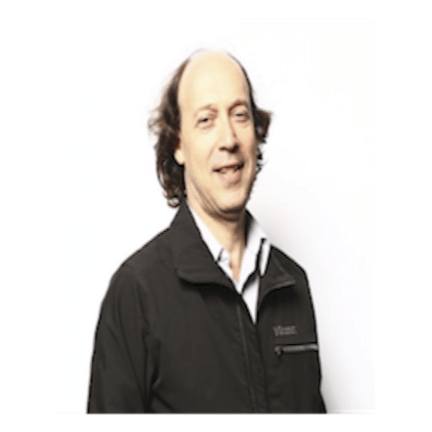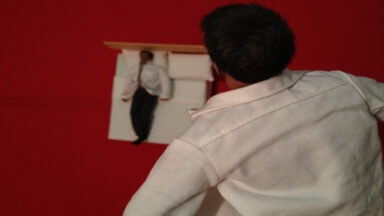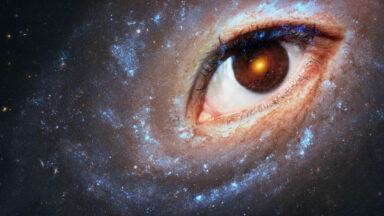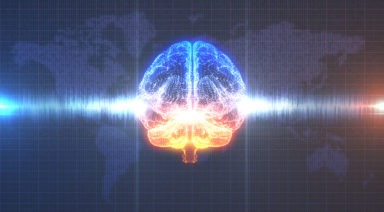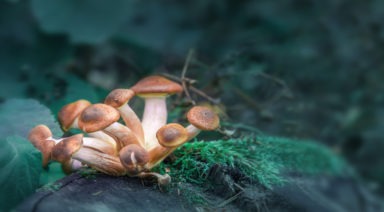What is Remote Viewing? Declassifying a Psychic Phenomenon

Remote viewing is the psychic ability to acquire accurate information about a distant or non-local place, person, or event without using your physical senses or any other obvious means. It’s associated with the idea of clairvoyance, seemingly being able to spontaneously know something without actually knowing how you got the information. It is also sometimes called “anomalous cognition” or “second sight.”
Many of us experience this from time to time as an intuitive flash of insight that turns out to be correct. Many well-known entrepreneurs and business people, like George Soros, Conrad Hilton, Thomas Alva Edison, and Akio Morita, the co-founder of Sony, have attributed their business success to this ability. And we’ve all seen natural psychics perform seemingly amazing feats of mental skill on TV.
The difference between natural psychic receptivity and remote viewing is that the latter is a trained skill, a controlled process, that the average person can learn to do to some degree.
This ability seems to be distributed in the human population in varying degrees, just like a musical skill—some people are really good at playing an instrument, but almost everyone can hum a tune or whistle.
History of the Remote Viewing Program
Remote viewing in modern times originates from the U.S. government’s interest in psychic espionage during the Cold War with the Soviet Union. Back during World War II, the Soviets had heard rumors that the U.S. military was using psychic spies and communications at sea. While it’s not clear now whether this was true, the Soviets believed it and started their own psychic training within their military and intelligence agencies many decades ago. The U.S. government learned of this program and, in the early 1970s, decided to create a remote viewing CIA training program.
Stanford Research Institute Remote Viewing Experiments
Money and resources were given by the Central Intelligence Agency to Stanford Research Institute (SRI), located on the campus of Stanford University at the time, to test the possibility of remote viewing. The goal was to disprove that psychic functioning was real. No one wanted it to exist. It was the last thing the military establishment wanted to worry about, especially if it was a new Soviet threat.
Physicists Russell Targ and Harold Puthoff, working at SRI, were tasked with determining whether extrasensory perception (ESP) and related phenomena were real or not (known as parapsychology). During their parapsychological research, Targ and Putoff set about to locate some natural psychics and test them. Their first subject was artist, psychic, and scientist Ingo Swann of New York City, who had demonstrated an ability to accurately “remote view” weather in various American cities. He also published some articles about ESP and psychokinesis (the ability to mentally affect distant objects) when he worked with researcher Gertrude Schmeidler of City College and the American Society for Psychical Research.
Working with Schmeidler, Swann had shown that he could affect the temperature of thermistors sealed in insulated thermos canisters twenty-five feet away from him. At a friend’s request, Swann sent his published findings to Putoff, who asked Swann to come to SRI and demonstrate his abilities. The first thing they had Swann do was to see if he could affect a super sensitive, electromagnetically shielded quark detector buried five feet underground in a cement floor. Every time Putoff asked Swann to think about the detector (used to detect subatomic particles), the readings from the device would noticeably deviate from the baseline readings. Putoff was convinced that Swann had special abilities, and so the program to test and develop remote viewing began.
Expanded Scope
At first, they had Swann view objects in a box; this was a practice he was good at but quickly became bored with. Swann said to them, “I can view anything in the universe; this is a trivialization of my abilities.” A few days later, he came up with a new way to do remote viewing: viewing map coordinates. Targ and Putoff went out and bought the biggest atlas they could find at the local bookstore. Swann’s coordinate map viewing turned out to be a big success. A critic at the Central Intelligence Agency suggested that maybe he had memorized the entire global map.
Swann went on to use randomly chosen numerical coordinates to view randomly selected events, people, and structures around the planet. He performed equally well using this coordinate-based viewing system.
Validation of Remote Viewers
Swann coined the term “remote viewing” to describe the process, though you can question whether the information is remote to the viewer or whether the process is entirely visual. Some people are more sensitive to auditory, kinesthetic, or other sensory types, and few viewers actually “see” the target very clearly. Nonetheless, the name stuck and was sufficient to convince the intelligence agencies to fund the project.
Other viewers were also tasked to help Targ and Putoff understand remote viewing. Pat Price, a former police commissioner from Burbank, California, also proved to be an excellent viewer. Price used his own system to view where he imagined that he was at the distant target site. His results were so good that the Central Intelligence Agency hired him to work for them directly. Back East, another natural viewer, Joe McMoneagle, also known as “Remote Viewer No. 1,” worked directly with the U.S. Army and the Defense Intelligence Agency. He was also tested and found to have amazing abilities to describe and sketch distant locations. Upon retirement, McMoneagle was awarded a Legion of Merit award, in part, for his five years of remote viewing missions for the military and various government agencies.
Coordinate Remote Viewing
However, Swann was able to describe, with great precision, what he was doing with his mind and attention as he was viewing, an ability other viewers did not have. This allowed him to come up with a 6-stage system that could be taught to anyone, including you or me. It became known as CRV: Coordinate (or Controlled) Remote Viewing.
Swann’s CRV system is based on separating out signal from noise in your mind as you are viewing. All the information is recorded during a session, but the viewer puts the noise in a different place on the paper than the signal. At the end of the session, you can separate them from one another. The method became the basis of the remote viewing protocols that the U.S. Army taught to several groups of viewers. The program continued until 1995, at which point it was declassified by the government. Over two decades, approximately $20 million of funding went to what eventually became known as the Stargate Project.
Princeton’s Random Number Generator Research
During this time, the Princeton Engineering Anomalies Research Lab (PEAR) at Princeton University, run by Bob Jahn and Brenda Dunn, also conducted twenty years of research into remote viewing and so-called “micro-psychokinesis” with experiments on the effect of human intention on Random Number Generators (RNGs). They found that looking at the cumulative results of hundreds of thousands of trials, their subjects could influence about 2 or 3 events per 10,000 random coin flips by seemingly moving the device away from true randomness in an inexplicable way. The odds of these results being by chance were an astonishing 375 trillion to one.
Scientific Analysis of the Program
When the Stargate program was declassified, one of the two people asked to evaluate the program was statistician Jessica Utts, the head of the American Statistical Association at the time of this writing. She concluded, “Using the standards applied to any other area of science, it is concluded that psychic functioning has been well established. Arguments that these results could be due to methodological flaws in the experiments are soundly refuted. Effects of similar magnitude to those found in government-sponsored research at SRI and SAIC (another government-sponsored think tank) have been replicated at several laboratories across the world. Such consistency cannot be readily explained by claims of flaws or fraud.”
Researcher Dean Radin, doing very complex meta-analyses using the results of many studies about psychic perception over many decades, came to the same conclusion. Looking at the entire population, not just trained viewers, remote viewing has a weak effect, about four to eight percent higher than expected if we were only using our physical senses to gather information; yet, it’s consistently there in everyone.
Coordinate Remote Viewing
However, Swann was able to describe, with great precision, what he was doing with his mind and attention as he was viewing, an ability other viewers did not have. This allowed him to come up with a 6-stage system that could be taught to anyone, including you or me. It became known as CRV: Coordinate (or Controlled) Remote Viewing.
Swann’s CRV system is based on separating out signal from noise in your mind as you are viewing. All the information is recorded during a session, but the viewer puts the noise in a different place on the paper than the signal. At the end of the session, you can separate them from one another. The method became the basis of the remote viewing protocols that the U.S. army taught to several groups of viewers. The program lasted until 1995 when it was declassified; about $20 million was spent over the two decades.
How Does Remote Viewing Work?
When someone asks you to describe something, you normally proceed to name what you’re perceiving using nouns and symbols. Remote viewing is just the opposite. You begin by describing your perceptions without trying to identify anything about what they mean or what the larger picture is. Start with basic gestalt: fundamental, general components of the target site, such as whether it’s manmade, living, or natural. You then proceed to basic colors, smells, temperatures, shapes, and sizes.
Only after you’ve been describing the target for a while can you proceed to more specific ideas and possibly names, nouns, and more analytical types of information.
In this way, Swann would say that you are opening the aperture of your perception slowly and resisting the temptation to draw conclusions about what you are viewing.
Follow the Ambiguity Methodology
Our minds are always attempting to conclude what we’ve perceived at any given moment, but because you have no conscious, physical information to work from in remote viewing, you’re almost always likely to be wrong if you do so. This brings us to one of the great paradoxes of remote viewing: the fainter the perception, the more likely it is to be accurate and the less likely you are to feel confident in that perception.
In other words, the more confident you are about your remote perceptions during the session, the less likely those perceptions are to be correct! And the less confident you feel, the more likely it is that your perceptions are right on. How’s that for a paradox?
Good remote viewers learn to trust the feelings of uncertainty and ambiguity they get while doing a session.
How to Learn Remote Viewing
If you’d like to learn how to remote view, pick up any books written by those who participated in the program, such as Joe McMoneagle, Lyn Buchanan, Paul Smith, Ingo Swann, Dale Graff, or any of the researchers like Russell Targ or Ed May who conducted and analyzed the early experiments. You might also want to read books from those who independently studied the phenomena after the official program closed, such as Dean Radin, Courtney Brown, or Angela Thompson Smith. And don’t hesitate to check out IRVA, the International Remote Viewers Association, which holds an annual conference.
No one entirely understands how it works, so you’re likely to learn the most by keeping an open yet reasonably skeptical mind as you read about the subject and perhaps try it out for yourself. If you’ve never had any spiritual or subtle awareness training before, try some meditation. Trust in your own experiences before trusting skeptics and their biases.
Astral Journey: What It Is, How to Do It, and What You Can Discover

An astral journey is a fascinating practice in which consciousness detaches from the physical body to explore the astral plane, a dimension of existence beyond the tangible world. In this article, we will delve into how an astral journey can be consciously induced, explore the transformative benefits it offers, and demystify the risks commonly associated with this ancient experience.
Table of Contents
- What Is an Astral Journey and What Is It For?
- Differences Between an Astral Journey and a Lucid Dream
- Step-by-Step Guide for a Safe Astral Journey
- How to Return from an Astral Journey
- Benefits of Astral Travel
- Dangers of Astral Travel
- Advancing in Astral Travel Practice
- Integrating Astral Travel into Daily Life
What Is an Astral Journey and What Is It For?
An astral journey is an experience in which consciousness separates from the physical body and moves through the astral plane, a non-material dimension that coexists with the physical world. Although many people experience it unconsciously while sleeping, it is possible to learn how to consciously and voluntarily induce these journeys through specific techniques of relaxation, meditation, and visualization.
This practice allows individuals to explore realities beyond the physical senses. Those who have had conscious astral journey experiences often describe an expansion of perception, encounters with other forms of consciousness, and access to information that is not available in the usual waking state.
The astral journey can be a tool for spiritual development and self-knowledge. By transcending the limits of the physical body, the practitioner can gain a deeper understanding of the nature of being, overcome the fear of death, and strengthen the connection with their spiritual essence.
In the third season of Mystery Teachings, available on Gaia, an entire episode is dedicated to astral journeys. There, Theresa Bullard shares effective techniques for initiating in the astral plane, addressing what should and should not be done, and demystifying several myths associated with the journey through the astral realms.
Differences Between an Astral Journey and a Lucid Dream
Although they may seem similar, an astral journey and a lucid dream are distinct experiences. In a lucid dream, the person becomes aware that they are dreaming and can control certain elements of the dream, but remains within the dream plane generated by the mind. In contrast, an astral journey involves the separation of consciousness from the physical body to explore a real and external plane, different from the internal world of dreams.
Additionally, the purpose and experience also differ. While lucid dreaming often has a recreational or symbolic component, the astral journey has a more experiential and spiritual nature. The level of clarity, intensity, and perception of reality in the astral plane is notably higher than in dreams, and the experiences obtained can have a profound impact on the practitioner’s daily life.
Step-by-Step Guide for a Safe Astral Journey
To have a safe astral journey, it is essential to follow a structured practice that combines mental preparation, physical relaxation, and visualization techniques. In Mystery Teachings, Theresa Bullard presents a progressive method that can be integrated into the daily routine as training. This step-by-step guide helps to induce astral projection gradually, consciously, and safely, allowing the practitioner to explore the astral plane with greater clarity and confidence.
- Preparatory meditation: Dedicate 15 minutes a day to meditate with your back straight. This posture favors the energy flow through the chakras and allows you to reach a receptive mental state.
- Initial visualization: Observe a white dot on a black background or vice versa. Then close your eyes and try to keep a clear mental image of the dot.
- Daily visual training: Practice this visualization every day for a week. This strengthens concentration and trains the mind to sustain images in deep relaxation states.
- Expansion of the dot: In the second week, mentally expand the visualized dot until it transforms into a large space. This space represents the threshold between the physical and the astral plane.
- Tunnel formation: Imagine that this space turns into a tunnel connecting both planes. Visualize yourself entering this transitional tunnel with your consciousness.
- Visualized destination: At the end of the tunnel, mentally create a specific place you want to reach. Keep your intention clear and use that goal as an anchor for the astral experience.
- Conscious movement: Move through the astral plane using the speed of thought. This form of movement allows you to explore the environment fluidly and without physical effort.
How to Return from an Astral Journey
The return to the physical body after an astral journey usually occurs naturally, as consciousness is permanently connected to the body through what many practitioners describe as the “silver cord.” In most cases, it is enough to direct attention toward the physical body or internally express the intention to return for the process to occur immediately. This reconnection is usually smooth, although some people may experience sensations of vibration or a slight jolt upon returning.
However, there are simple techniques that can facilitate a more conscious and gradual return. Slightly moving the fingers of the hands or feet, taking a deep breath, or visualizing the physical body as an anchoring point are effective methods to reintegrate without abruptness. With practice, the return to the body becomes increasingly natural, allowing the experience to be concluded in a balanced way and wakefulness to be resumed with clarity and stability.
Benefits of Astral Travel
Astral travel offers a wide range of spiritual and personal benefits, allowing practitioners to explore beyond physical limitations and gain new perspectives on life and existence. Reaching these states of consciousness can result in a profound sense of liberation and knowledge, alleviating fears such as the fear of death and strengthening the connection with the higher self and spiritual dimensions.
- Expansion of consciousness: Astral travel allows one to experience a broader reality beyond daily life, promoting greater mental openness and flexibility in thinking.
- Understanding life after death: Practicing astral projection can provide comfort and insight into what might exist beyond physical life, reducing the fear of death.
- Development of psychic abilities: Through astral travel, some people report an increase in their intuitive and psychic abilities, such as clairvoyance or extrasensory perception.
- Emotional healing: Consciously revisiting past experiences from an astral perspective can provide new understanding that helps in the emotional healing process.
- Increased creativity: Astral travel can inspire individuals by giving them access to visions and ideas beyond the reach of conventional thought.
Dangers of Astral Travel
Although astral travel is safe, there are certain myths that may cause concern among practitioners. It is important to clarify these myths to ensure that participants feel comfortable and secure during their astral experiences. Understanding that these “dangers” are largely unfounded can help practitioners approach astral travel with confidence and peace of mind.
- Fear of not returning to the physical body: A common myth is the fear of getting stuck in the astral plane and not being able to return to the physical body. However, the so-called “silver cord,” which connects the astral body to the physical body, is not something that can be broken. Instead, it is a metaphorical connection that always ensures the return to the body.
- Encounters with negative entities: Some practitioners express concern about encountering malicious entities during their travels. Protecting oneself with light visualizations and setting clear and firm intentions for safety before the journey can help avoid these experiences and ensure a positive astral environment.
- Disorientation and fear: For beginners, it is common to feel some disorientation or fear when exploring astral experiences for the first time. These feelings are usually mild and can be easily managed with practice and preparation. Learning control techniques and cultivating a positive mental environment before starting the journey can help overcome these moments and improve the overall experience.
Advancing in Astral Travel Practice
For those interested in deepening their astral travel practice, it is essential to develop a consistent routine and employ advanced meditation and visualization techniques. As practitioners gain more experience, they can begin to explore various aspects of the astral plane with greater control and purpose. This includes learning to navigate to specific locations, interact with different spiritual entities, and receive teachings or guidance.
Additionally, sharing experiences with a community of practitioners can be invaluable. Joining groups or workshops where techniques and personal experiences are discussed helps validate and enrich one’s journey in astral travel. The guidance of an experienced mentor can also be a great advantage, offering the opportunity to learn through direct teaching and receive feedback that is crucial for personal and spiritual growth in this practice.
Integrating Astral Travel into Daily Life
Integrating astral travel into daily life means more than just having out-of-body experiences; it involves applying the perceptions and teachings obtained during these journeys to everyday physical existence. For example, insights gained about personal challenges or behavioral patterns can be used to improve relationships, make more informed decisions, and cultivate greater inner peace.
On the other hand, regularly practicing astral travel can foster a sense of spiritual connection and purpose that transcends mundane activities. This may manifest as greater empathy toward others, a commitment to service or community, and an interest in additional spiritual practices that complement personal growth. For those who deeply integrate these practices, astral travel becomes a way of life that fully embraces the multidimensional nature of human existence.

